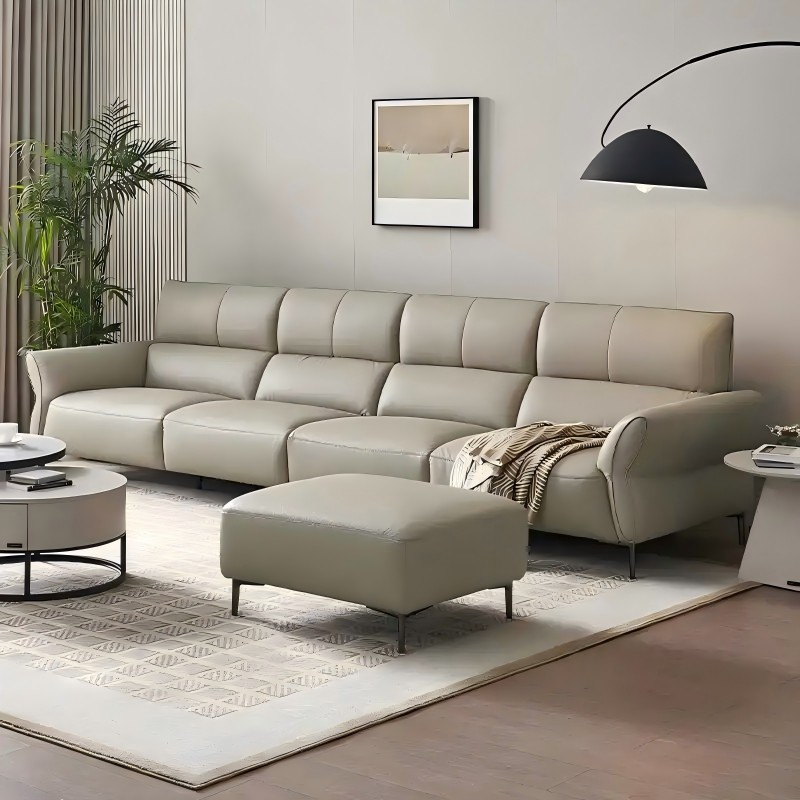Handmade leather sofa: The Scientific Truth and Investment Wisdom behind Luxury
요약
Handmade leather sofas are a symbol of high-end home furnishing, with both artistic value and practical functions.This article analyzes its core advantages and disadvantages from the six dimensions of material characteristics, environmental protection and health, climate adaptability, pet compatibility, price investment and maintenance science, citing international standards and authoritative research, to provide consumers with a rational shopping guide.

1. Material grade and comfort science
The core of the quality of handmade 가죽 소파 lies in the type of leather:
– Full-grain first layer skinRetains natural pores and texture, and has the best breathability. Experiments have proved that its surface temperature is 2-3℃ lower than that of fabric, and it feels more comfortable in summer.
-Semi-green leatherIs lightly polished, which is cost-effective but slightly less breathable; Embossed leather enhances wear resistance through machining, but sacrifices part of the skin-friendly feeling.
The filling process is also critical.High-end products use High-density sponge and down layered mixing, cushion pressure dispersion technology reduces the pressure value of the buttocks by 18%, and it remains comfortable for 4 hours of continuous sedentary sitting.It should be noted that those who are too thin may experience discomfort due to excessive flank support. It is recommended to choose a style with adjustable backrest angle.
2. Environmental disputes and health truths
There are two polar evaluations of the environmental protection of leather sofas:
-Hidden dangers of hazardous substances: Formaldehyde adhesives and chromium salts are required for leather tanning, and the formaldehyde incubation period of some inferior products is 3-15 years.The EU REACH regulations strictly limit the content of dimethyl fumarate (DMF) ≤0.1mg/kg to prevent skin allergies.
-Sustainable advantages: The natural degradation cycle of dermis is 25-30 years, which is more than 60% shorter than that of synthetic materials.International certifications (such as OEKO-TEX) can trace the source of raw materials to ensure compliance with production.
China’s new national standard GB 18584-2024 implemented in July 2025 included leather furniture in the supervision for the first time, requiring formaldehyde release ≤0.08mg/m3 and benzene total ≤0.41mg/m3 to promote industry upgrading.
3. Climate adaptability challenges
Temperature and humidity are the “invisible killer” of cortical life:
-High humidity environment (humidity>65%) is easy to breed mildew. During the rainy season in the Yangtze River Basin, dehumidification is required for 4 hours a day to maintain a humidity range of 45%-55%.
-Dry environment (humidity <40%) accelerates cracking, and Harbin’s winter complaints are 11 times that of Guangzhou.The solution is to match a humidifier to prevent the water content of the leather from falling below 12%.
Data warning: The color fastness of genuine leather decreases by 60% after 6 months of exposure to the window, and the installation of gauze curtains with a shading rate of more than 70% is necessary for protection.
4. Pet family compatible plan
Pets and leather sofas are often regarded as “natural enemies”:
-Root cause of risk: The pressure of the cat’s paw can reach 200kPa, which exceeds the tear resistance threshold of cowhide.Cats with uncut nails scratched 50 times a day, and obvious scratches appeared in half a year.
-Scientific protection: The use of linen anti-scratch cloth with latitude and longitude density>500T, combined with citral-containing repellents, can reduce the frequency of scratching by 70%.Minor scratches can be temporarily repaired with egg white, and deep damage requires professional filling.
5. Price password and investment attributes
The high price of handmade leather sofas stems from the triple cost:
- Material cost: Imported first-layer cowhide accounts for 35%-40% of the selling price, and the bending strength of the Russian birch frame reaches 85MPa, which is better than that of domestic wood by 22%.
- Process cost: Hand-sewing takes 15 minutes per extension meter, the labor cost is 3 times that of the mechanism product, and the unit price of the manual model is 2.5 times that of the mechanism model.
The investment potential is significant: the ten-year residual value rate of well-maintained classic models is 35% (the fabric is less than 10%), and the auction price of a single chair by an Italian designer in the 1970s is 12 times the original price.Circulation requires the support of a material appraisal certificate from a professional institution.
6. Maintenance science and life extension
Proper maintenance can extend life for decades:
-The daily ”three avoidance” principle: avoid high temperature (>40℃), avoid strong acids (pH<3), and avoid oil pollution.The liquid splashes need to be sucked dry within 30 seconds, and the permeability surges in more than 2 minutes.
-Professional “3+1” system: quarterly cleaning and fat replenishment + annual sterilization and waterproof.Sofas that adhere to in-depth maintenance for ten years are 6-8 years younger than those that are not maintained.
Case: Italian brand tracking shows that the annual nursing sofa is still as warm as ever after 20 years of use.
Summary: Rational investment, scientific maintenance
Handmade leather sofa is A complex of art and function-it provides irreplaceable texture and durability, but needs to deal with environmental disputes, climate sensitivity and pet risks; it has the potential for appreciation, but relies on strict maintenance and professional certification.Consumers should:
- Look for certification: Priority is given to OEKO-TEX label and GB 18584-2024 compliance products;
- Matching scene: Strengthen dehumidification in humid areas, and match protection for pet families;
- Investment classic: Choose manual frame + first layer leather configuration, annual professional maintenance.
Under the wave of sustainable consumption, high-end leather sofas are transforming from “luxury consumer goods” to “inheritable artistic assets”.As the Japan Furniture Association said: “The luster of leather is a combination of time and care.”
